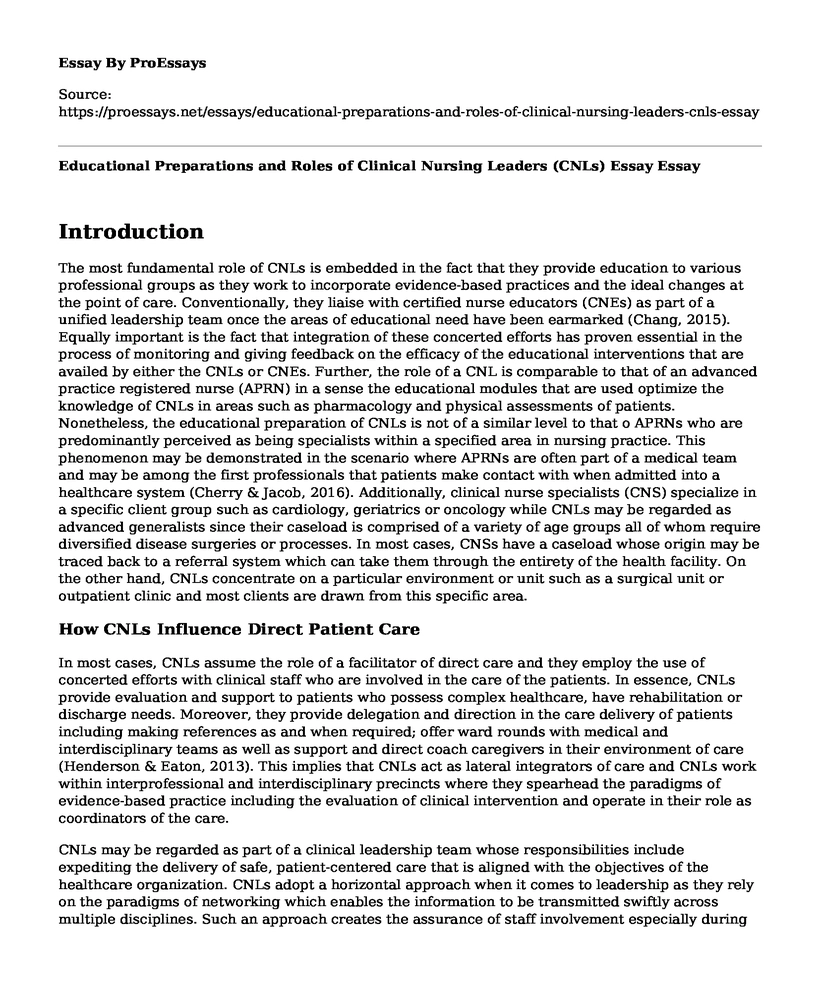Introduction
The most fundamental role of CNLs is embedded in the fact that they provide education to various professional groups as they work to incorporate evidence-based practices and the ideal changes at the point of care. Conventionally, they liaise with certified nurse educators (CNEs) as part of a unified leadership team once the areas of educational need have been earmarked (Chang, 2015). Equally important is the fact that integration of these concerted efforts has proven essential in the process of monitoring and giving feedback on the efficacy of the educational interventions that are availed by either the CNLs or CNEs. Further, the role of a CNL is comparable to that of an advanced practice registered nurse (APRN) in a sense the educational modules that are used optimize the knowledge of CNLs in areas such as pharmacology and physical assessments of patients. Nonetheless, the educational preparation of CNLs is not of a similar level to that o APRNs who are predominantly perceived as being specialists within a specified area in nursing practice. This phenomenon may be demonstrated in the scenario where APRNs are often part of a medical team and may be among the first professionals that patients make contact with when admitted into a healthcare system (Cherry & Jacob, 2016). Additionally, clinical nurse specialists (CNS) specialize in a specific client group such as cardiology, geriatrics or oncology while CNLs may be regarded as advanced generalists since their caseload is comprised of a variety of age groups all of whom require diversified disease surgeries or processes. In most cases, CNSs have a caseload whose origin may be traced back to a referral system which can take them through the entirety of the health facility. On the other hand, CNLs concentrate on a particular environment or unit such as a surgical unit or outpatient clinic and most clients are drawn from this specific area.
How CNLs Influence Direct Patient Care
In most cases, CNLs assume the role of a facilitator of direct care and they employ the use of concerted efforts with clinical staff who are involved in the care of the patients. In essence, CNLs provide evaluation and support to patients who possess complex healthcare, have rehabilitation or discharge needs. Moreover, they provide delegation and direction in the care delivery of patients including making references as and when required; offer ward rounds with medical and interdisciplinary teams as well as support and direct coach caregivers in their environment of care (Henderson & Eaton, 2013). This implies that CNLs act as lateral integrators of care and CNLs work within interprofessional and interdisciplinary precincts where they spearhead the paradigms of evidence-based practice including the evaluation of clinical intervention and operate in their role as coordinators of the care.
CNLs may be regarded as part of a clinical leadership team whose responsibilities include expediting the delivery of safe, patient-centered care that is aligned with the objectives of the healthcare organization. CNLs adopt a horizontal approach when it comes to leadership as they rely on the paradigms of networking which enables the information to be transmitted swiftly across multiple disciplines. Such an approach creates the assurance of staff involvement especially during decision making, unlike the more conventional vertical hierarchy which is dependent on an individual's position of power (Melnyk, 2013). Perhaps CNL success may be demonstrated in its wide adoption in the Veterans Health Administration (VHA) facilities where the roles of these professionals have yielded remarkable success. These may include the decline in sitter hours for patients diagnosed with dementia, an increase in the nursing hours per patient day and the reduction in ventilator-associated pneumonia.
References
Chang, E. (2015). Transitions in nursing: Preparing for professional practice. Elsevier Health Sciences.Cherry, B., & Jacob, S. R. (2016). Contemporary nursing: Issues, trends, and management (7th ed.). St. Louis, MO: Elsevier. ISBN-13: 9780323390224 Read Chapter 17 Contemporary Nursing: Issues, Trends, and Management.
Henderson, A., & Eaton, E. (2013). Assisting nurses to facilitate student and new graduate learning in practice settings: what 'support'do nurses at the bedside need?. Nurse Education in Practice, 13(3), 197-201.
Melnyk, B. M. (2013). Distinguishing the preparation and roles of doctor of philosophy and doctor of nursing practice graduates: National implications for academic curricula and health care systems. Journal of Nursing Education, 52(8), 442-448.
Cite this page
Educational Preparations and Roles of Clinical Nursing Leaders (CNLs) Essay. (2022, Jul 06). Retrieved from https://proessays.net/essays/educational-preparations-and-roles-of-clinical-nursing-leaders-cnls-essay
If you are the original author of this essay and no longer wish to have it published on the ProEssays website, please click below to request its removal:
- Time Management Tips for Learners
- Cases Involve the Death of Employees Paper Example
- The Impact of Technology in Nursing Essay Example
- E-Cigarettes Smoking - Essay Sample
- Essay on Nutrition: Knowing Macronutrients Is Key for Achieving Fitness Goals
- Sustainable Forest Management Leadership: British Columbia (B.C.) Leading the Way - Essay Sample
- Black Women Leaders: Examining Empowerment Through Q-Sort Methodology - Essay Sample







